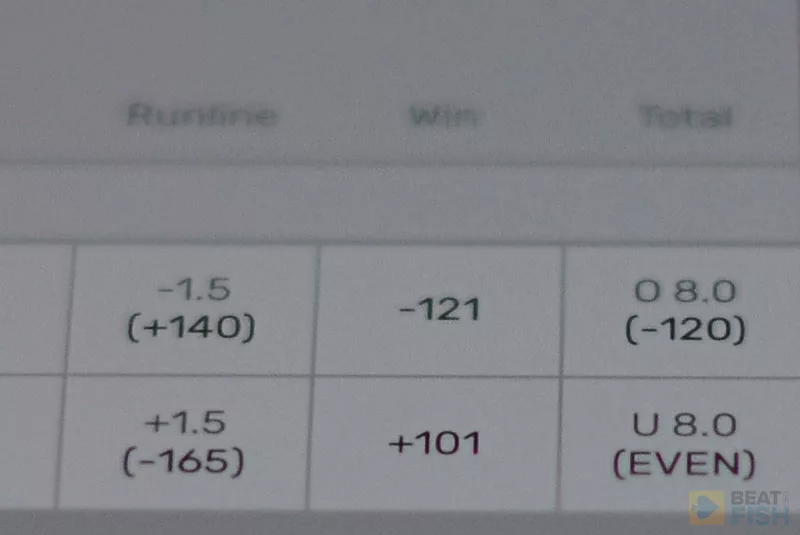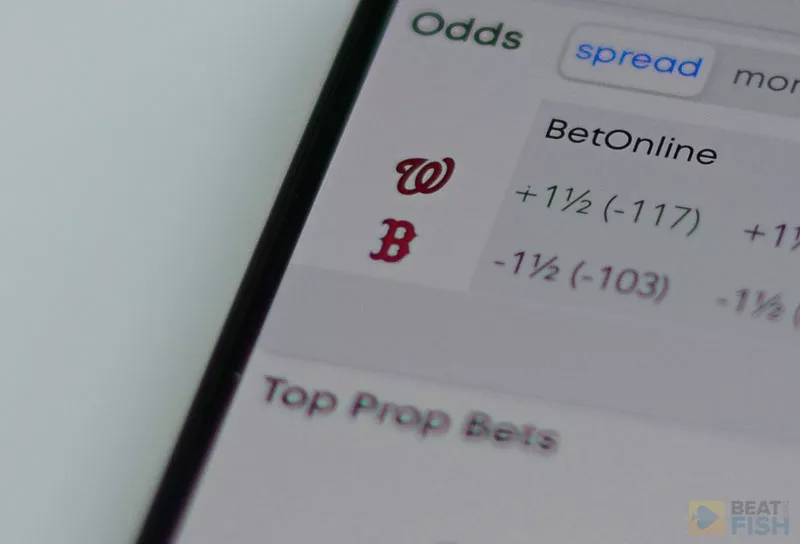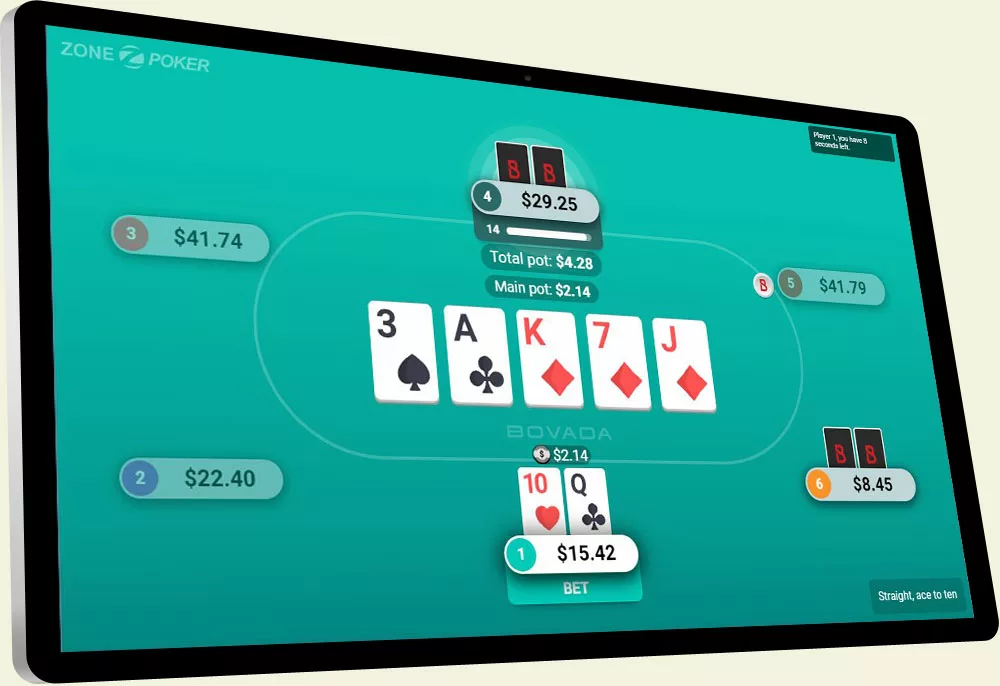Betting Odds Explained and Today’s Games
This is where you’ll find today’s betting lines across multiple leagues. We currently show up-to-date odds for MLB, NBA, NHL, NFL, NCAA football, and NCAA basketball.
View our free picks page for our expert best bets on today’s lines.
Table of Contents
Point Spreads
Understanding point spreads and money lines is crucial in sports betting. Let’s start with point spreads, which is mostly used in bets on football and basketball.
Point spreads level the playing field for bettors by adding or subtracting points to the final score.
When you bet on the favorite team, they must win by more than the spread for your bet to pay out. On the other hand, betting on the underdog means they just need to lose by less than the spread (or win the game outright) for your bet to be a winner.
It’s like a head start given to the underdogs and a handicap imposed on the favorites. Point spreads allow for more diverse betting strategies because they not only focus on picking winners, but also on predicting margins of victory. This opens up opportunities for informed bettors to identify value bets based on their analysis of teams’ strengths and weaknesses relative to the spread.
For instance, if the Kansas City Chiefs are favored to beat the Las Vegas Raiders by 10 points, a bet placed on the Chiefs will only pay out if they win by more than 10 points. Conversely, if a bet is placed on the Raiders, they can win the game outright or lose by less than 10 points for the bet to succeed.
If the Chiefs win by exactly 10, a bet on either side is refunded. This is called a push or a tie.
Moneylines
Moneylines are typically used in sports such as baseball and hockey or in other sports where the spread is small. You can also make moneyline bets on players to win in individual sports like tennis, MMA, golf, or boxing.
Moneylines provide a straightforward way to bet on who will win a game without involving any point spread consideration.
It’s simply about picking the team that you think will emerge victorious – whether they win by one point or by a landslide.
The moneyline indicates how much must be wagered or how much you could potentially win on a $100 bet.
When you see negative numbers in money lines, it signifies the amount that must be wagered in order to win $100. That team is the favorite. Heavy favorites can garner moneylines of -300 or worse when they’re playing a vastly inferior opponent.
For example, if the powerhouse Los Angeles Dodgers are playing the rebuilding Colorado Rockies, the Dodgers may be a -310 favorite. That means you’d have to wager $310 on the Dodgers just to win $100. Experienced bettors generally don’t bet on extreme lines like that.
On the contrary, positive numbers indicate how much profit could be won from a $100 wager. You would be betting the underdog on the moneyline. For example, if you bet $100 on the New York Giants as a +360 underdog to upset the Philadelphia Eagles, you would win $360.
Run (or Puck) Line
In baseball and hockey, the games are lower scoring than football or basketball and thus a significant point spread would be impractical.
There is a standard -1.5 (for favorites) and +1.5 line (for underdogs) offered by sportsbooks for every baseball and hockey game.
It works just like a point spread, where betting the -1.5 line would require your team to win by 2 or more to win your bet. Betting the underdog would win if your team wins or loses by 1. Of course, you can avoid the spread by just betting the moneyline, but the run line gives you the chance to save on juice for the favorite or still win if the underdog keeps it close.
Whereas a -110 price is standard for normal point spreads, sportsbooks adjust the juice for the run line to compensate for the difference in the teams’ win probability. For example, if the moneyline indicates that two teams are closely matched, then getting a +1.5 run line on the slim underdog will be heavily juiced.
Totals
When looking at our odds pages and lines and sportsbooks, you’ll come across many totals.
Instead of betting on who will win and by how much, totals allow you to bet on total points in a variety of situations.
The simplest form of a total is a full-game total. This is a main betting line that you’ll see listed next to the moneyline and spread. With a full-game total, you’re betting on the combined total number of runs, points, or goals by both teams in the game.
You can also bet on an individual’s team total, often abbreviated as TT. In a sport like tennis, you can bet on the total number of games or sets. In combat sports, the total number of rounds.
There are numerous variations of totals you can bet on, which will differ by sport:
- Baseball: F5 (first five innings), NRFI (no runs in the first inning), team totals
- Basketball: 1Q (first quarter), 1H (first half), team totals
- Hockey: 1P (first period), team totals
- Football: 1Q (first quarter), 1H (first half), team totals

Juice (or vig)
Also known as vigorish or vig, juice is the fee charged by a sportsbook for accepting wagers. It ensures that the bookmaker turns a profit, regardless of the event’s outcome. This fee is factored into the odds and serves as part of the risk management for bookmakers, ensuring their profitability.
The juice is where they make their money. It’s the fee or commission that sportsbooks charge for accepting your bets. It’s kind of like the “price of admission” to get in on the action.
Here’s an example: Let’s say a sportsbook offers odds at -110. What does this mean? It means that if you want to win $100, you need to bet $110. This effectively incorporates a 10% juice. So, even though it might look like a 50/50 chance of winning, the odds are adjusted so that the sportsbook makes a profit either way.
The standard juice on a spread or total is -110, but this can be adjusted up to +100 or down as far as -130 to reflect which side the sportsbook wants action on.
You’ll also experience heavy juice when betting on favorites, as the sportsbook sets a higher price on teams more likely to win. They don’t want you getting an even-money bet on a team that will probably win the game.
In highly competitive markets, bookmakers may strategically lower the juice to attract more bettors. By offering lower juice, bookmakers aim to entice bettors to place their wagers with them rather than their competitors. This fierce competition can lead to more favorable odds for bettors as bookmakers adjust the juice to gain a competitive edge.
Line shopping
One of the key tactics for managing sports betting juice is line shopping. When you hear “line shopping,” it’s not about searching for discounts at the supermarket, but rather comparing the vigorish offered by different sportsbooks for the same event. It’s like scouting various stores to find the best price for an item.
By scanning multiple sportsbooks, which we display on our odds pages, you can identify the most favorable terms and potentially maximize your payouts.
Imagine you want to buy a new gadget. You wouldn’t simply settle for the first price you see, right? Instead, you’d check different stores to ensure you get the best deal. Similarly, line shopping allows you to explore various sportsbooks to find the most advantageous odds and lower juice, allowing you a better profit margin for your bets. Keep in mind that even tiny differences in juice can significantly impact your potential payout.

How Bookmakers Set Odds
Ever wondered how those numbers next to your favorite team’s name come to be? Bookmakers are the masterminds behind this magical spell of odds.
Their main goal is to set odds that tempt people on both sides of a bet while mitigating the sportsbook’s risk.
Sportsbooks don’t just pluck odds out of thin air. They rely on a complex blend of statistical analysis, historical data mining, and market understanding. They factor in various aspects such as team performance, player injuries, weather conditions, and venue effects. For example, if it’s raining, teams may play more conservatively in football games, potentially leading to lower overall scoring. These details influence how they set the initial betting lines.
Furthermore, their job isn’t just about predicting the probable outcome of a game. The odds they set are also influenced by the betting public’s sentiment and behavior. If there’s a sudden influx of bets on one side of a game, bookmakers may adjust the odds to balance their book and minimize potential losses.
Sportsbooks also often collaborate with professional oddsmakers and data analysts to ensure the accuracy and competitiveness of their odds. They use statistical models and algorithms to determine the initial odds for a sporting event.
Factors Influencing Odds Setting
Bookmakers consider an array of factors when setting odds:
- Team Records: A team’s past performance heavily influences its future odds.
- Player Injuries: The absence or presence of key players significantly impacts a team’s chances of winning.
- Weather Conditions: Certain sports are more affected by weather conditions than others; for instance, rain or snow in outdoor sports can significantly change game dynamics.
- Public Betting Patterns: Bookmakers keep an eye on where the general public is placing their bets.
This thorough analysis allows them to create initial odds that reflect the most likely outcomes while also accounting for betting trends among the general public.
For instance, let’s say a star quarterback gets injured before a big game. Sportsbooks will quickly adjust the odds to account for the flurry of betting activity on the opposing team.
Favorites and Underdogs
Favorites are the teams or individuals expected to win, so they have lower odds, meaning a higher probability of winning but with a lower payout. Conversely, underdogs are the underdogs, with higher odds offering a lower chance of winning, but a potentially higher payout if they do indeed win.
Favorites are akin to playing it safe. You’re more likely to get a return on your bet, but it may not be as substantial. Underdogs present an exciting prospect; while they carry a lesser chance of success, the potential payout can be significant. The key is to find the right balance that aligns with your risk tolerance and goals.
In many cases, especially for casual bettors, the allure of high payouts from underdogs can be irresistible. However, it’s important to remember that the bookmakers are shrewd experts who set the probabilities in their favor. While underdogs can be extremely rewarding when they hit, they’ll lose much more frequently than favorites.






